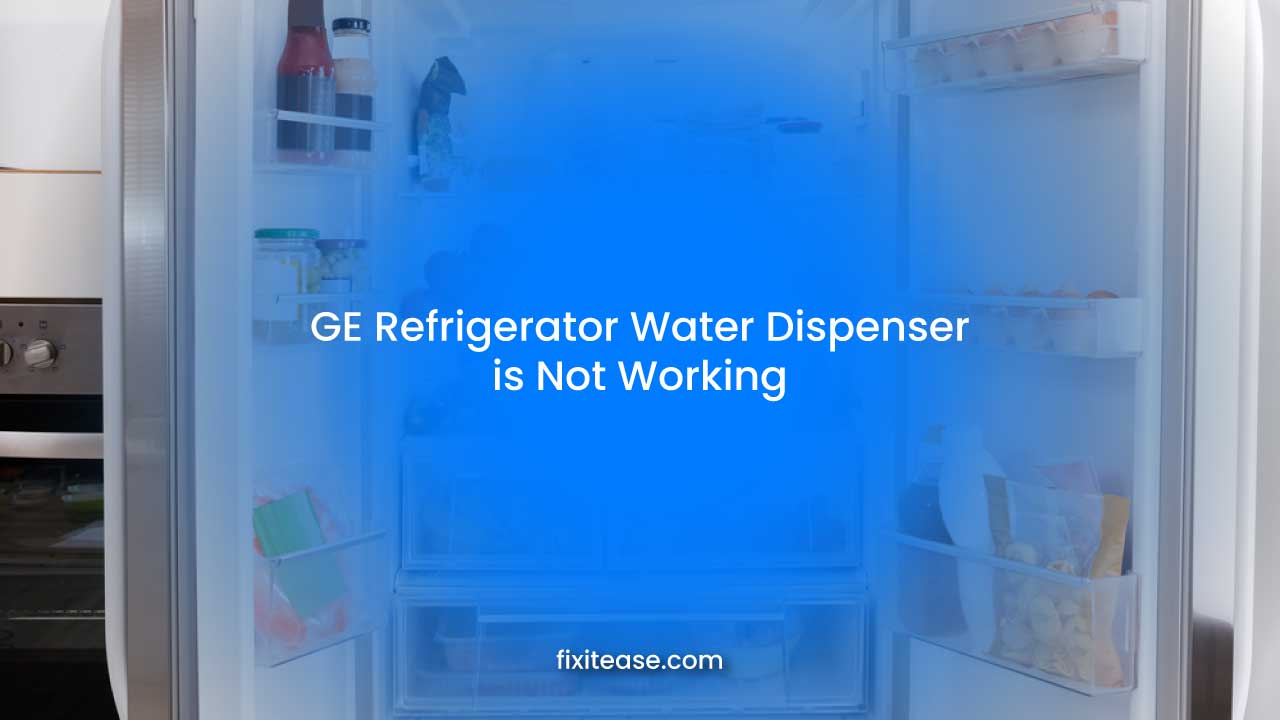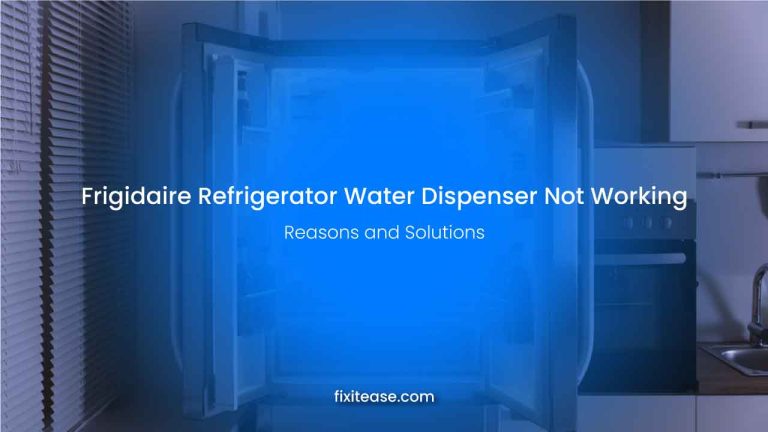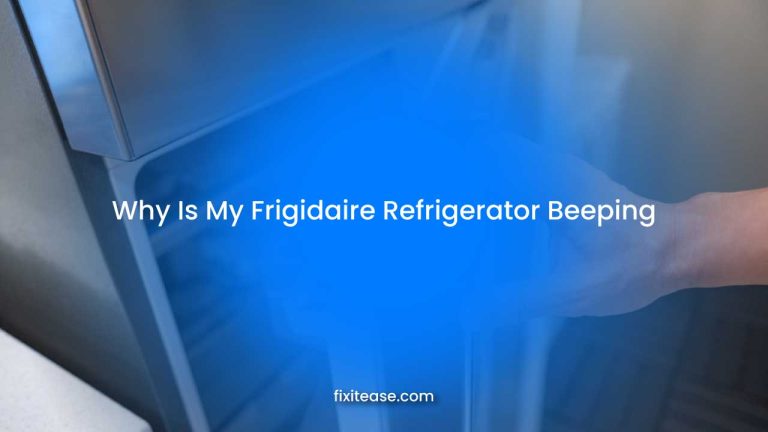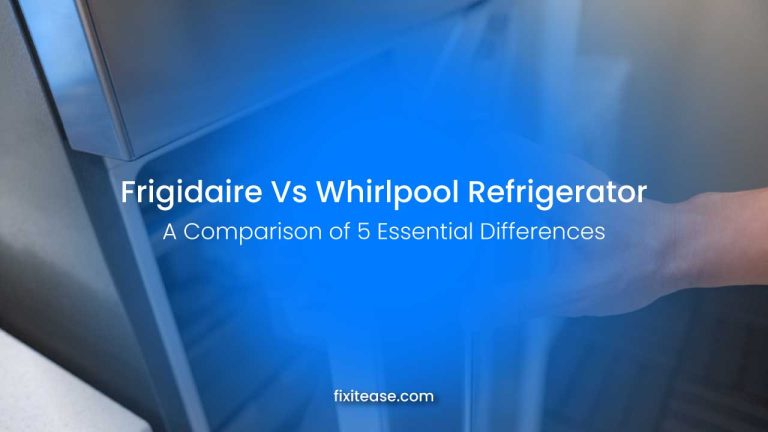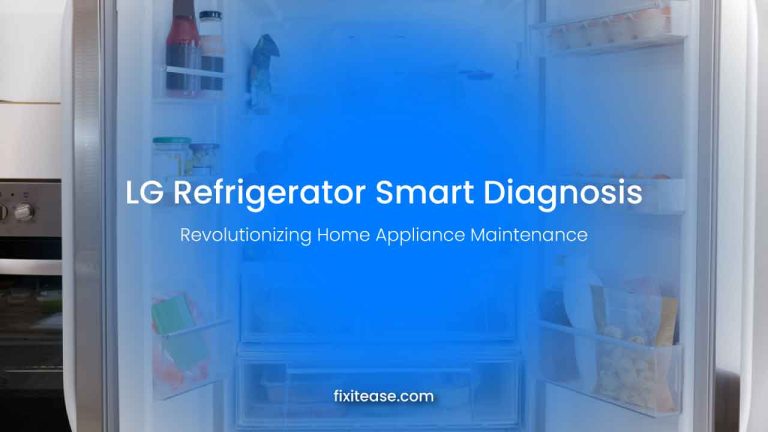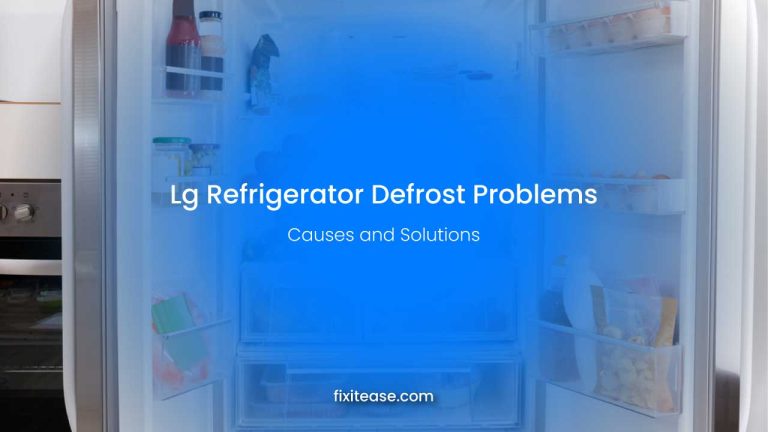GE Refrigerator Water Dispenser is Not Working
If your GE refrigerator’s water dispenser isn’t working, it’s often due to a clogged water filter or a frozen water line. Simple fixes like replacing the filter or thawing the line often resolve the issue.
I know how frustrating it can be when you reach for a cold glass of water and nothing happens. I’m here to help you understand and tackle this issue.
In my journey with appliances, issues with water dispensers are usually not as daunting as they seem. There are straightforward solutions, whether a blocked supply line, a faulty valve, or just a minor hiccup in the system. I’m excited to share these insights with you, ensuring your GE refrigerator is back to providing refreshing water in no time.
What Is GE Refrigerator’s Water Dispenser

Your GE refrigerator’s water dispenser works straightforwardly. It typically features a lever or button that, when pressed, releases water from a supply line connected to your fridge. This gives you immediate access to fresh, cold water right from the door.
The water passes through a filter inside your fridge, crucial for removing impurities and improving taste. However, this filter can become clogged over time, leading to issues with the dispenser. Knowing these basic components and their functions can simplify troubleshooting problems. It’s all about the little details that ensure your dispenser provides clean, refreshing water whenever needed.
Common Causes of Water Dispenser Issues
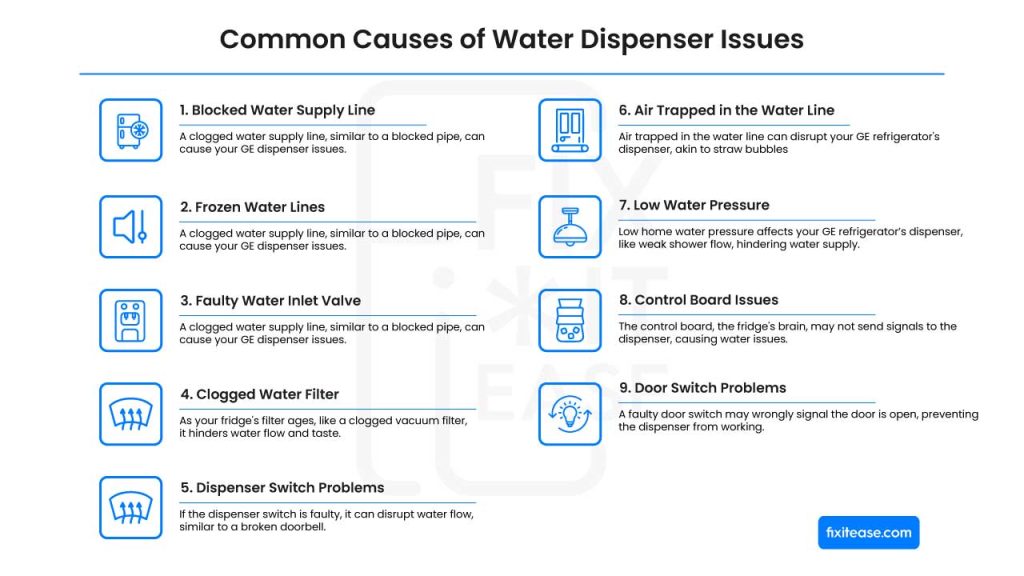
When your GE refrigerator’s water dispenser stops working, it can be due to a few common issues. Let’s break these down in simple terms:
1. Blocked Water Supply Line
A blocked water supply line is a common reason your GE refrigerator’s water dispenser might stop working. Think of it like a clogged pipe under your sink. Over time, tiny particles or mineral deposits from your water can build up in the line that feeds water to your fridge.
This blockage stops the flow, just like a kink in a garden hose would. When your sink gets slow to drain, but instead of water going down, it’s not coming out. The good news is this is often an easy fix. You may need to clean the line or, in some cases, replace a section. Keeping an eye on the water flow and addressing any slow-down early can help prevent a full blockage.
2. Frozen Water Lines
Frozen water lines are similar to how outdoor pipes can freeze in winter. Inside your fridge, especially in models with the freezer over the fridge compartment, the lines carrying water can get too cold and freeze. This stops water from flowing through them like a frozen garden hose in winter.
The key to fixing this is gently thawing the lines without damaging them. Sometimes, adjusting your fridge’s temperature settings can prevent this. It’s a simple issue but can be a bit tricky, so keeping your fridge at the right temperature is an excellent way to avoid it.
3. Faulty Water Inlet Valve
A faulty water inlet valve is another common reason that can stop your GE refrigerator’s water dispenser from working. Think of this valve as a small gate that controls water flow into your fridge. When it works right, it opens to let water in and closes to stop the flow.
But if it’s faulty, it’s like having a gate that won’t open properly, so water can’t get through. This could be due to normal wear and tear or sometimes an electrical problem. Fixing this usually means replacing the valve. It’s a bit like fixing a leaky faucet – not too complicated, but it’s essential to get it right to ensure your dispenser works smoothly.
4. Clogged Water Filter
Your fridge’s filter cleans the water, making it taste better and removing unwanted particles. But over time, just like a vacuum cleaner filter, it can fill up everything it’s filtering out. Water struggles to get through when this happens, much like trying to drink a thick milkshake through a straw.
The solution is usually as simple as replacing the filter. It’s like changing a light bulb – straightforward and can make a big difference. Regularly changing the water filter is easy to ensure your dispenser keeps working well and your water stays clean and fresh.
5. Dispenser Switch Problems
The dispenser switch is like a doorbell for your fridge – when you press it, it tells the refrigerator to release water. If this switch isn’t working, it’s like a broken doorbell; your fridge doesn’t get the message to dispense water. This could be due to a mechanical fault, like the switch getting stuck, or an electrical issue, like a loose connection.
Fixing this might be as simple as adjusting the switch to ensure it’s making contact. In some cases, though, it might need replacing. It’s a bit like fixing a sticky key on a keyboard – sometimes, a slight adjustment is all it takes to get things working smoothly again. Keeping an eye on the dispenser’s response when you press the switch can help you catch any early signs of trouble.
6. Air Trapped in the Water Line
Air trapped in the water line of your GE refrigerator can cause issues with the water dispenser. It’s like trying to drink a soda through a straw and get those annoying air bubbles. The liquid flow gets interrupted. In your fridge, air pockets in the water line can stop the water from flowing smoothly. This can happen after replacing the water filter or doing some kind of maintenance on the fridge.
The good news is this is usually an easy fix. You can often clear the air by dispensing water continuously for a few minutes. This process allows the trapped air to escape and the water to flow normally again. It’s a simple step, but it can make a big difference in getting your water dispenser back in working order.
7. Low Water Pressure
Low water pressure in your home can impact your GE refrigerator’s water dispenser, much like a weak shower flow. If the pressure is too low, pushing water through the dispenser may not be sufficient. This issue could stem from problems with your home’s main water supply or a partially closed valve leading to the fridge.
It’s akin to a garden hose not fully turned on – the water trickles out weakly. To resolve this, check and ensure the main water valve for your home and the fridge’s supply line are fully open. Proper water pressure is essential for a consistent and reliable flow from your dispenser.
8. Control Board Issues
The control board acts like the fridge’s brain, managing various functions, including the water dispenser. This might mean the control board isn’t sending the right signals to the dispenser, resulting in no water being released.
Diagnosing and fixing it often requires a professional’s expertise. It’s like troubleshooting a complex electronic device – sometimes, it needs a skilled hand to identify and resolve the issue. Ensuring the control board functions correctly is crucial for the overall performance of your refrigerator’s water dispensing system.
9. Door Switch Problems
Many refrigerators have a safety feature where the dispenser won’t operate if the door is open. If the door switch is faulty, it might incorrectly signal that the door is open, even when closed. When the fridge thinks the door is open, it won’t allow the dispenser to release water as a safety precaution.
Fixing this usually involves adjusting or replacing the door switch. It’s like fixing a misaligned sensor – a minor tweak can restore the system’s functionality, ensuring the dispenser works only when it’s supposed to.
Troubleshooting Steps for Water Dispenser Problems
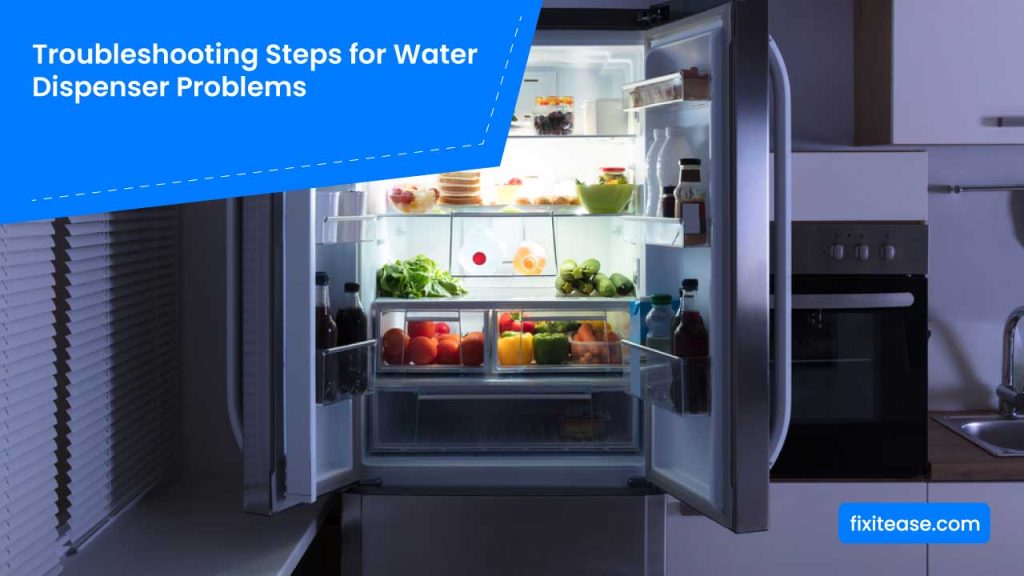
When your GE refrigerator’s water dispenser stops working, it can be a source of frustration and inconvenience. But don’t worry. Troubleshooting and fixing the issue is often simpler than you might think. In this guide, we’ll walk through the common problems and their solutions, helping you get your water dispenser back to its best with minimal hassle.
Check for a Blocked Water Supply:
- First, locate the water supply line at the back of your fridge. It’s usually a thin tube.
- Disconnect this line from both the fridge and the water source.
- Check for any visible blockages or kinks in the line.
- You can also blow air through it or run water through it to ensure it’s clear.
- If you find a blockage, gently remove it and reconnect the line.
Thaw a Frozen Water Line:
- Identify if the water line inside the fridge is frozen. This is common in the lines close to the freezer.
- Turn off the fridge and open the doors to allow the temperature to rise, which will slowly thaw the line.
- Alternatively, you can use a hair dryer on a low setting to warm the line gently, but be careful not to overheat any part.
Test and Replace the Water Inlet Valve:
- Locate the water inlet valve, usually at the back of the fridge where the water line connects.
- Test the valve with a multimeter to check for continuity. If it shows no continuity, it needs replacing.
- To replace it, disconnect the water supply, remove the faulty valve, and install a new one, ensuring all connections are secure.
Change the Water Filter:
- Find the water filter, usually inside the refrigerator compartment.
- Remove the old filter by either turning it or pushing it in, depending on your model.
- Insert the new filter, making sure it’s properly seated and locked in place.
- Run water through the dispenser for a few minutes to clear any air and contaminants from the new filter.
Check and Repair the Dispenser Switch:
- Locate the dispenser switch, which is usually behind the lever or button you press to dispense water.
- Check for any physical damage or misalignment. Adjust if necessary.
- Use a multimeter to test for continuity. If there’s no continuity, the switch may need replacing.
- Replace the switch if needed, ensuring all connections are secure and properly aligned.
How to Maintain The GE Refrigerator Water Dispenser
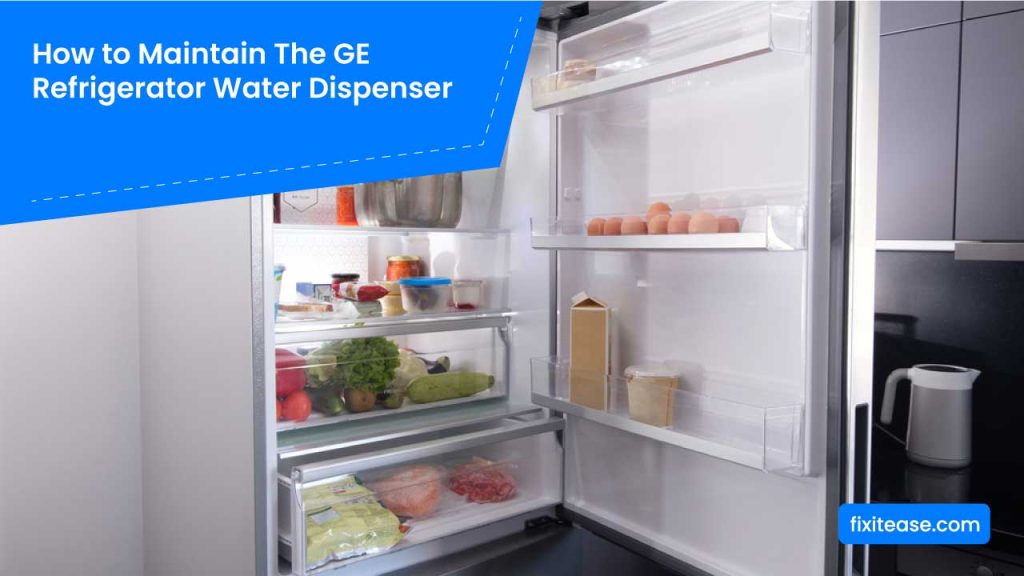
Maintaining your GE refrigerator’s water dispenser is critical to ensuring its longevity and optimal performance. Here’s a comprehensive guide combining essential and additional maintenance tips:
Regular Cleaning and Maintenance:
- Clean the dispenser’s exterior with a damp cloth to prevent dirt buildup.
- Inspect and clean the dispenser lever or button for any stickiness.
- Flush the water system every few months by dispensing several gallons of water.
When to Change the Water Filter:
- Change the filter every six months or sooner if there’s a decrease in water flow or taste change.
- Use the correct filter type for your specific refrigerator model.
Avoiding Common Issues:
- Keep the refrigerator’s temperature at a recommended level to prevent the water line from freezing.
- Ensure the area behind your fridge is clear to avoid blocking the water supply line.
- Monitor your home’s water pressure; low pressure can affect dispenser performance.
Inspect and Clean the Dispenser Nozzle:
- Regularly check and clean the nozzle to prevent blockages and maintain hygiene.
- Use a mild cleaning solution and a soft cloth to avoid damaging the nozzle.
Check and Tighten Connections:
- Periodically check the water line connections for any looseness and tighten them as needed.
- Ensure that the hose isn’t pinched or bent, which could restrict water flow.
Monitor for Unusual Noises:
- Be alert to any changes in sound from your dispenser, which could indicate a problem.
- If unusual noises persist, consider consulting a technician to prevent further issues.
Keep the Fridge Level:
- Ensuring your refrigerator is level can prevent water line issues.
- Use a level tool to check and adjust the fridge’s position periodically.
Consult the User Manual:
- Regularly refer to your refrigerator’s user manual for model-specific maintenance advice.
- Keep an eye out for any updates or additional tips from the manufacturer.
FAQ
What should I do if my GE fridge’s water dispenser is slow or has low pressure?
A clogged water filter or low home water pressure can cause low water pressure. Replace the water filter if it’s been more than six months, or check your home’s water pressure. Ensuring the water supply valve is fully open can also help improve water flow.
How often should I change my GE refrigerator’s water filter for optimal performance?
It’s recommended to change your GE refrigerator’s water filter every six months or sooner if you notice a decrease in water flow or a change in water taste. Regular replacement ensures clean, fresh-tasting water and optimal dispenser performance.
Can a faulty water inlet valve cause my GE fridge’s water dispenser to stop working?
Yes, a faulty water inlet valve can prevent your refrigerator’s water dispenser from working. If the valve is damaged or fails to open, it won’t supply water to the dispenser. Testing the valve with a multimeter for continuity can help determine if it needs replacing.
What are the signs of dispenser switch problems in a GE refrigerator?
If pressing the dispenser lever or button doesn’t release water, or if there’s a delay or irregular response, it could indicate a problem with the dispenser switch. This might require adjusting the switch for proper contact or replacing it if it’s faulty.
Conclusion
The challenge of a non-functioning GE refrigerator water dispenser might seem overwhelming at first, but as we’ve explored, it’s often a matter of addressing simple issues. From thawing frozen lines to changing filters, these are tasks you can confidently handle. Regular maintenance and a keen eye for the early signs of trouble can save you time and hassle.
A well-maintained dispenser is more than just a convenience; it’s a daily source of hydration. So, embrace these tips, and you’ll find yourself well-prepared to ensure a steady flow of fresh, clean water from your fridge—cheers to solving problems and enjoying the simple pleasure of a well-functioning home appliance.

